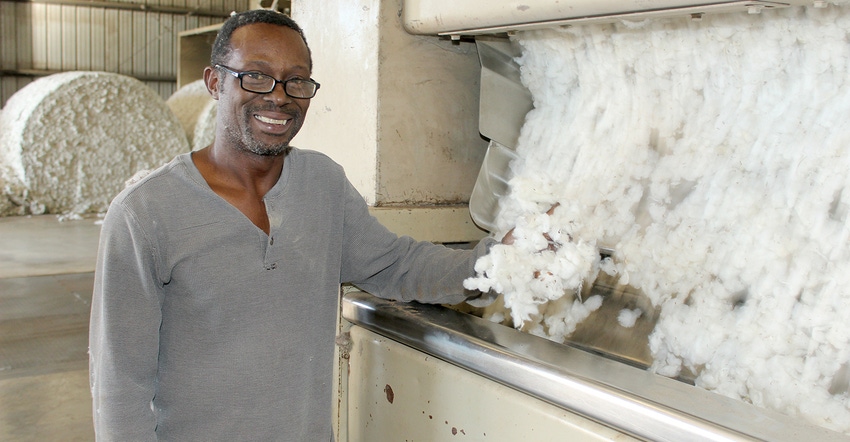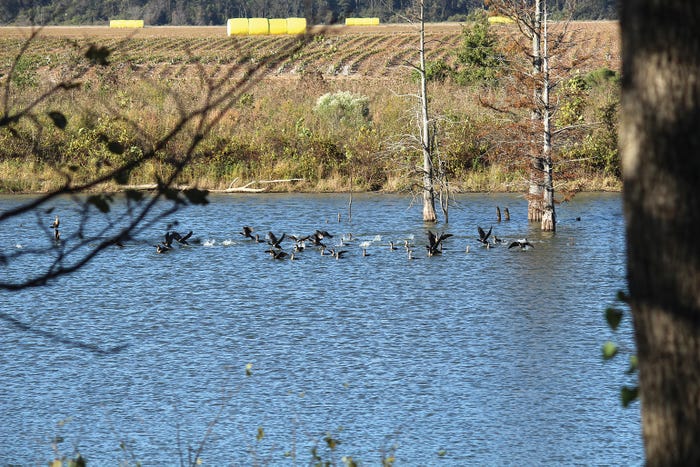
The McClendon, Mann & Felton three-stand cotton gin near Hughes, Ark., and their larger five-stand gin in Marianna, Ark., are operating around the clock with alternating shifts. The gins cranked up around the beginning of October, nearly three weeks later than last year.
“We had too much cool and wet weather during the summer months, and that really held the crop back from reaching maturity like it normally should have,” says Larry McClendon, president of the ginning operations. “We ginned in the neighborhood of 116,000 bales in 2016, and I think we’ll surpass that total this year.”
Like other producers around the Mid-South have reported, the fields looked impressive after being defoliated, but once pickers started rolling, yield monitors started confirming the crop was not measuring up to how it looked from the turnrow.
“I wish I could put my finger on it. Some fields are very good, but field-by-field, there’s just not the consistency we were hoping for — we have a lot of weak spots,” he says.
McClendon has seen a number of fields with expansive areas of variability that are obviously contributing to the low yield monitor readings which are, on average, 150 pounds an acre lower than anticipated.

Double-breasted cormorants take flight from a body of water between Hughes and Marianna, Ark., as groups of round modules in the distance wait for module truck drivers to deliver them to the gin.

Double-breasted cormorants take flight from a body of water between Hughes and Marianna, Ark., as groups of round modules in the distance wait for module truck drivers to deliver them to the gin.
Future changes
The yellow, round modules staged in groups of four visible on Hwy. 79 South, starting around Hughes and continuing all the way into Marianna, confirm the massive volume of seed cotton that needs to be hauled and subsequently ginned. According to Anthony Brooks, supervisor at the Hughes facility, moisture content in the cotton ginned so far has been consistent – between 5 and 6 percent.
When asked if there will be any equipment changes or upgrades to either of the gins after the ginning season, McClendon said those decisions will be based on 2018 planting intentions and are usually made around March or April.
“From harvesting conditions and quality of the seed cotton delivered to the gin, to cottonseed prices and capital expenditures, there are so many factors that directly impact and challenge a ginning operation’s profitability,” says Tim Price, executive vice president, Southern Cotton Ginners Association.
“I always equate the ginning business to the grocery business,” says McClendon. “It takes volume to be profitable. Each year we have to increase the number of bales we gin because our fixed costs are always going up.”
Luckily, the two gins are modern with reliable equipment. The Marianna gin was built in 2002, and the gin plant on the outskirts of Hughes was built in 2005. While traditional seed cotton modules can still be found on their gin yards, over the last three years each gin has seen a consistent increase in the number of round modules being delivered.
“I think in eight to 10 years, we probably won’t see any of the rectangular modules any more, but right now there’s still a good number of traditional pickers across the country, and I think as long as those pickers remain operational, we’ll still see a few of the modules formed by module builders,” says McClendon. “But once those pickers wear out, I’m guessing those producers will replace them with on-board module harvesters.”
This past February, the McClendon, Mann & Felton families celebrated the 100th anniversary of the Marianna gin’s history. Recently retired Farm Press senior director of content Forrest Laws published an in-depth retrospective feature on the celebration with an accompanying video that can be found at http://www.deltafarmpress.com/cotton-gins/mcclendon-mann-felton-gin-celebrates-100-years.
About the Author(s)
You May Also Like




